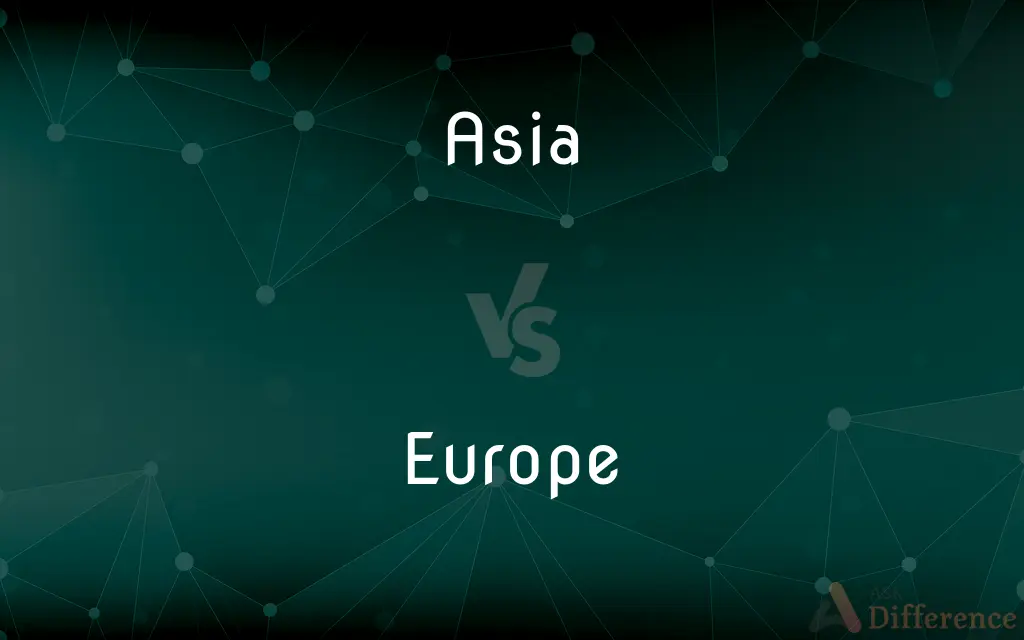Asia vs. Europe — What's the Difference?
Edited by Tayyaba Rehman — By Fiza Rafique — Updated on April 16, 2024
Asia is the largest continent in terms of both area and population, rich in diverse cultures and languages; Europe, though smaller, boasts significant economic and historical influence globally.

Difference Between Asia and Europe
Table of Contents
ADVERTISEMENT
Key Differences
Asia is the world's largest and most populous continent, home to a vast range of geographic features from vast deserts to extensive mountain ranges. In contrast, Europe is significantly smaller in both area and population, but it is densely populated and highly urbanized, making it an epicenter of economic and political activity.
Asia is characterized by its immense cultural and linguistic diversity, with thousands of languages spoken across various countries. Whereas Europe, while also culturally diverse, has a more homogeneous linguistic landscape, dominated primarily by Indo-European languages.
Economically, Asia features both some of the world’s fastest-growing economies, like China and India, and regions with considerable poverty. On the other hand, Europe generally displays more uniform economic development and higher average incomes, with strong economies like Germany and France leading.
In terms of political influence, Asia has rising global powers such as China and India that are increasingly shaping international politics and economics. Europe, on the other hand, remains a significant traditional power through entities like the European Union, which plays a crucial role in global diplomatic and economic standards.
Asia’s climate ranges from the arctic cold of Siberia to the tropical climates of Southeast Asia. Europe’s climate is more temperate, with a smaller range in climatic conditions but significant variation in weather patterns across its regions.
ADVERTISEMENT
Comparison Chart
Area
Largest continent
Smaller than Asia
Population
Most populous
Less populous
Economic Diversity
Extreme variance
More uniformly developed
Political Influence
Emerging global leaders
Traditional powers
Climate
From arctic to tropical
Generally temperate
Compare with Definitions
Asia
Asia is Earth's largest continent by both area and population.
Asia encompasses a vast array of geographic and cultural diversity.
Europe
Europe is a continent defined by its historical and cultural influence rather than its size.
Europe has been a central point of Western history and culture.
Asia
Known for its myriad cultures and languages.
Asia is home to more than 2,000 languages.
Europe
Often acts cohesively through the European Union.
The European Union allows for unified economic policies among its member states.
Asia
Features both booming economies and areas of severe poverty.
Asia's economic landscape includes leading economies like Japan and developing nations like Cambodia.
Europe
Characterized by high levels of income and development.
European nations like Sweden and Germany are noted for their strong economies.
Asia
Hosts some of the most diverse climatic zones in the world.
Asia includes the coldest town on Earth, Oymyakon, and tropical climates like those in Thailand.
Europe
Features a predominantly temperate climate.
Europe’s climate ranges from the Mediterranean in the south to continental in the center and oceanic in the northwest.
Asia
A region of rising geopolitical significance.
Asian countries like China are becoming dominant players on the global stage.
Europe
Predominantly speaks Indo-European languages.
Major European languages include English, French, and German.
Asia
Asia ( (listen)) is Earth's largest and most populous continent, located primarily in the Eastern and Northern Hemispheres. It shares the continental landmass of Eurasia with the continent of Europe and the continental landmass of Afro-Eurasia with both Europe and Africa.
Europe
Europe is a continent located entirely in the Northern Hemisphere and mostly in the Eastern Hemisphere. It comprises the westernmost peninsulas of the continental landmass of Eurasia, and is bordered by the Arctic Ocean to the north, the Atlantic Ocean to the west, the Mediterranean Sea to the south, and Asia to the east.
Asia
The largest continent with 60% of the earth's population; it is joined to Europe on the west to form Eurasia; it is the site of some of the world's earliest civilizations
Europe
The 2nd smallest continent (actually a vast peninsula of Eurasia); the British use `Europe' to refer to all of the continent except the British Isles
Asia
The nations of the Asian continent collectively
Europe
An international organization of European countries formed after World War II to reduce trade barriers and increase cooperation among its members;
He took Britain into Europe
Europe
The nations of the European continent collectively;
The Marshall Plan helped Europe recover from World War II
Common Curiosities
Which continent is more populous, Asia or Europe?
Asia is more populous than Europe, with over 4 billion people.
How do the economies of Asia and Europe differ?
Asia displays a broader economic spectrum from high-growth nations to underdeveloped areas, while Europe is more uniformly developed.
What is the role of the European Union in Europe?
The EU plays a key role in political, economic, and legislative matters among its member states.
What defines the boundary between Asia and Europe?
The boundary is generally considered the Ural Mountains and the Ural River.
What are the political differences between Asia and Europe?
Asia is home to emerging global powers while Europe maintains traditional influence through structures like the EU.
Which continent is larger in area, Asia or Europe?
Asia is larger than Europe.
Which continent has more languages, Asia or Europe?
Asia has a significantly higher number of languages compared to Europe.
Which continent has a greater diversity in climate, Asia or Europe?
Asia has a greater climatic diversity, ranging from arctic to tropical climates.
What climate types are found in Europe?
Europe mostly experiences temperate and Mediterranean climates.
What type of economic entities are prominent in Europe?
Europe is known for its high-income, well-developed economies.
What historical impacts have shaped Europe's current culture?
Europe's culture is heavily influenced by historical periods like the Renaissance and the Enlightenment.
How do living standards in Asia compare with those in Europe?
Living standards in Asia vary widely, whereas Europe generally has higher and more uniform standards.
Can you describe a major cultural festival from each continent?
Asia: Diwali, known as the Festival of Lights in India. Europe: Oktoberfest, a world-famous beer festival in Germany.
Are there more countries in Asia or Europe?
Asia has more countries than Europe.
How does cultural diversity in Asia compare with Europe?
Asia exhibits greater cultural and linguistic diversity than Europe.
Share Your Discovery

Previous Comparison
Acknowledge vs. Admit
Next Comparison
Retailer vs. VendorAuthor Spotlight
Written by
Fiza RafiqueFiza Rafique is a skilled content writer at AskDifference.com, where she meticulously refines and enhances written pieces. Drawing from her vast editorial expertise, Fiza ensures clarity, accuracy, and precision in every article. Passionate about language, she continually seeks to elevate the quality of content for readers worldwide.
Edited by
Tayyaba RehmanTayyaba Rehman is a distinguished writer, currently serving as a primary contributor to askdifference.com. As a researcher in semantics and etymology, Tayyaba's passion for the complexity of languages and their distinctions has found a perfect home on the platform. Tayyaba delves into the intricacies of language, distinguishing between commonly confused words and phrases, thereby providing clarity for readers worldwide.















































